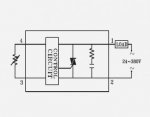Good afternoon,
Currently we are in process of getting ETL listing mark for an appliance we manufacture (120Vac/25Amps). The testing laboratory is checking to see if the appliance complies to the requirements of UL197 standard (Commercial electrical cooking appliance) and CSA C22.2 no.109, which is a Canadian standard for the same. Accordingly to the standards requirements, all electric components in primary circuit must be UL listed or UL recognized.
Now to the issue. The appliance has a heating element (1600W), the power supplied on which is regulated by adjustable SSR (phase control type). Basically, this SSR is a common dimmer controlled by a potentiometer. The exact model is FOTEK SSR-25VA (http://www.fotek.com.tw/Ecenter2.asp?product_sn=508&class2_sn=18). There are no galvanic decoupling between control and load circuits in this SSR unit. In other words, the potentiometer actually is in primary circuit under main voltage (120Vac) applied on it, see the diagram below:

So, the testing lab claims that we must use UL recognized potentiometer in this case; however, the problem is that I can't find variable resistors/potentiometers/rheostats at the UL database website (http://database.ul.com/cgi-bin/XYV/cgifind/LISEXT/1FRAME/index.html). Moreover, I asked many potentiometer manufacturers, and it has been revealed that they don’t offer UL recognized potentiometers. The manufacturer of SSR also couldn’t suggest any UL recognized potentiometer.
It seems quite strange, because the SSR-25VA unit is UL recognized (UL file #E208225), and the UL database contains a lot of components, but there are almost no potentiometers itself. Kind of paradox: there is a UL recognized SSR unit but there are no UL recognized potentiometer to use along it.
Please advise if someone have had similar experience with using UL recognized potentiometers.
Currently we are in process of getting ETL listing mark for an appliance we manufacture (120Vac/25Amps). The testing laboratory is checking to see if the appliance complies to the requirements of UL197 standard (Commercial electrical cooking appliance) and CSA C22.2 no.109, which is a Canadian standard for the same. Accordingly to the standards requirements, all electric components in primary circuit must be UL listed or UL recognized.
Now to the issue. The appliance has a heating element (1600W), the power supplied on which is regulated by adjustable SSR (phase control type). Basically, this SSR is a common dimmer controlled by a potentiometer. The exact model is FOTEK SSR-25VA (http://www.fotek.com.tw/Ecenter2.asp?product_sn=508&class2_sn=18). There are no galvanic decoupling between control and load circuits in this SSR unit. In other words, the potentiometer actually is in primary circuit under main voltage (120Vac) applied on it, see the diagram below:

So, the testing lab claims that we must use UL recognized potentiometer in this case; however, the problem is that I can't find variable resistors/potentiometers/rheostats at the UL database website (http://database.ul.com/cgi-bin/XYV/cgifind/LISEXT/1FRAME/index.html). Moreover, I asked many potentiometer manufacturers, and it has been revealed that they don’t offer UL recognized potentiometers. The manufacturer of SSR also couldn’t suggest any UL recognized potentiometer.
It seems quite strange, because the SSR-25VA unit is UL recognized (UL file #E208225), and the UL database contains a lot of components, but there are almost no potentiometers itself. Kind of paradox: there is a UL recognized SSR unit but there are no UL recognized potentiometer to use along it.
Please advise if someone have had similar experience with using UL recognized potentiometers.


